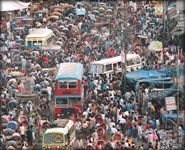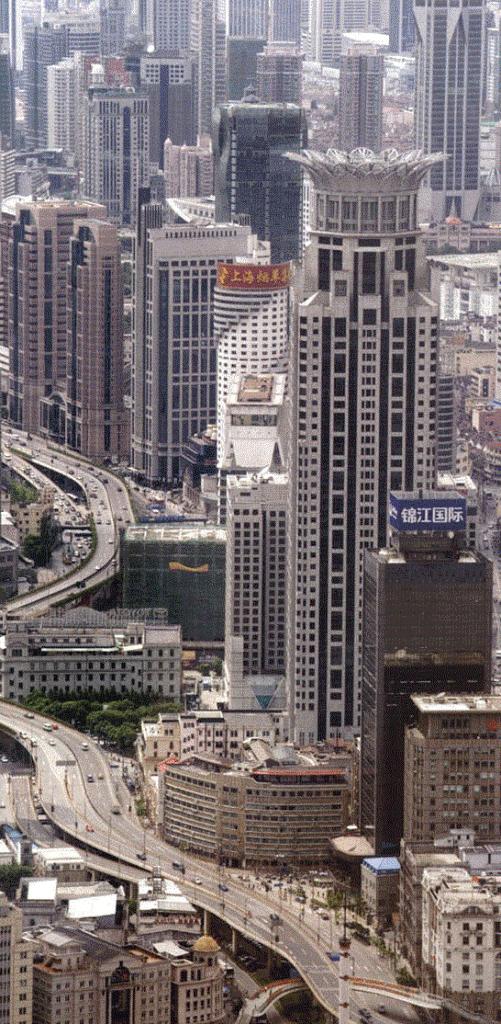Urbanization in the Context of Development
The first picture is of Dacca, Bangladesh; the second is of Shanghai, China.
Contents:
Agenda
Sources for Presentation
General Reading Assignment
Handouts
Powerpoints
General Reading Assignment for the entire class:
Bloom, David E. and Tarun Khanna, (2007), “The Urban Revolution”, Finance and Development, September, pp. 9-14.
Glaeser, E., (2011), “Cities, Productivity, and Quality of Life”, Science, Vol. 333 pp 592-594.
Provisional Agenda
( To view the sources for a paper, click on the title.)
I. OPENING REMARKS
II. THE ECONOMIC CAUSES OF URBANIZATION
“Do Large Cities Have a Bright Future?”
“Why Does City Size Increase Productivity?”
“What Are the Causes of Urban Primacy in the Third World?”
“What is Driving Urbanization in China?”
III. THE EFFECTS OF URBANIZATION
“Is Urbanization Degrading the Environment?”
“Is Urbanization Causing Income Inequality and Poverty?”
IV. SUMMARY AND CONCLUSIONS
Sources for Presentations:
II. THE CAUSES OF URBANIZATION IN THE THIRD WORLD
Do Large Cities Have a Bright Future?
Gaigne, C. and J. Thisse, (2009), “Aging Nations and the Future of Cities”, Journal of Regional Science, Vol. 49, No. 4, pp 663-688. (Consider only pp. 663-666 and 684-686.
Gaspar, Jess; Glaeser, Edward L. (1998), Information Technology and the Future of Cities”, Journal of Urban Economics v43, n1 (January 1998): 136-156. [Omit pp 139-146.]
Glaeser, Edward L. (1998), “Are Cities Dying?”, Journal of Economic Perspectives v12, n2 (Spring 1998): 139-160.
McCann, P. and Z. Acs, (2011), “Globalization: Countries, Cities and Multinationals”, Regional Studies, Vol. 45, No. 1, pp 17-32. (Consider only pp 17-24 and pp 28-29.)
If you would like to write your term paper on this topic, click here to see some suggested sources.
“Why Does City Size Increase Productivity?
Andersson, Roland; John M Quigley; Mats Wilhelmson, (2005),”Agglomeration and the spatial distribution of creativity”, Papers in Regional Science, pp. 445-464. (Consider only pp 445-448 and page 462.)
Bertinelli, L. and B. Zou, (2008), “Does Urbanization Foster Human Capital Accumulation?”, Journal of Developing Areas, Vol. 41, No. 2, pp171-184. (Consider only pp. 171-172, 178)
Compton, Janice; Robert Pollak, (2007), “Why Are Power Couples Increasingly Concentrated in Large Metropolitan Areas?”, Journal of Labor Economics, Vol. 25, No. 3, pp. 475-511. (Consider only pp 475-479 and page 505, 506.)
Echeverri-Carroll, E. and S. Ayala, (2009), “Wage differentials and the spatial concentration of high technology industries”, Papers in Regional Science, Vol. 88, No. 34, pp 623-639. (Consider only pp 623-227 and pp. 637)
Fafchamps, Marcel and Forhad Schlipi, (2005), “Cities and Specialization: Evidence from South Asia”, The Economic Journal, vol. 115, pp. 477-504.(Consider only pp 477-481 and pp. 501,502.)
Gill, I. and C. Goh, (2010), “Scale Economies and Cities”, World Bank Research Observer, Vol. 25, pp. 235-262. (Consider only pp 235-237)
Peri, Giovanni (2002), “Young Workers, Learning, and Agglomerations”, Journal of Urban Economics v52, n3 (November 2002): 582-607. [Omit sections 3 and 4.]
If you would like to write your term paper on this topic, click here to see some suggested sources.
“What Are the Causes of Urban Primacy in the Third World?”
Bertinelli, L. and Strobl, E., (2007), “Urbanisation, Urban Concentration and Economic Development”, Urban Studies, Vol. 44, No. 13, pp. 2499-2510. (Consider pp 2499-2501 and 2506)
Gill, I. and C. Goh, (2010), “Scale Economies and Cities”, World Bank Research Observer, Vol. 25, pp. 235-262. (Consider only pp 247-251)
Henderson, Vernon (2002), “Urban Primacy, External Costs, and Quality of Life”, Resource and Energy Economics v24, n1-2 (February 2002): 95-106.
Moomaw, R. and M. Alwosabi, (2004), “An empirical analysis of competing explanations of urban primacy: evidence from Asia and the Americas”, The Annals of Regional Science, Vol. 38, pp 149-171., (Consider only pp 149-151 and pp 167.)
Mutlu, Servet (1989), “Urban Concentration and Primacy Revisited: An Analysis and Some Policy Conclusions” in Economic Development and Cultural Change, Vol. 37, No. 3 April 1989, pp. 611-639. [Omit pp. 620-625]
Short, J. and L. Pinet-Peralta, (2009), “Urban Primacy: Reopening the Debate”, Geography Compass, Vol. 33, No. 3, pp 1235-1266. (Omit section on data issues and problems, pp 1248-1254.)
If you would like to write your term paper on this topic, click here to see some suggested sources.
What is Driving Urbanization in China?
Au, C. and J. V. Henderson, (2006), “Are Chinese Cities Too Small?”, Review of Economic Studies, Vol. 73, pp 549-576. (Consider only pp. 549 and 571.)
Au, C. and J. V. Henderson, (2006), “How migration restrictions limit agglomeration and productivity in China”, Journal of Development Economics, Vol. 80, pp 350-388. (Consider only pp. 350-355.)
Chen, Y., (2009), “Agglomeration and location of foreign direct investment: The case of China”, China Economic Review, Vol. 20, pp 549-557 (Consider only Section 1 , Introduction and Section 5, Conclusions.)
Deng, Xiangzheng, Jikun Huang, Scott Rozelle and Emi Uchida, (2008), “Growth, Population and Industrialization, and Urban Land Expansion in China”, Journal of Urban Economics, Vol. 63, , pp. 96-115 (Consider only pp. 96-99 and pp. 113.)
Li, Bingqin and David Pichaud, (2006), “Urbanization and Social Policy in China”, in Asia-Pacific Development Journal, vol. 13, No. 1, June, pp. 1-21.
Li, Zhang, (2012) “Economic Migration and Urban Citizenship: The Role of Points Systems”, Population and Development Review, Vol. 38, No. 3, pp 503-533. (Consider only pp 503-506 and pp 521-522)
Xu, Z. and N. Zhu, (2008), “Urban Growth Determinants in China”, The Chinese Economy, Vol. 41, No. 1, pp 7-35. (Consider only pp 7-10 and pp. 32.)
Zhang, Kevin Honglin (2002), “What Explains China’s Rising Urbanisation in the Reform Era?”, Urban Studies v39, n12 (November 2002): 2301-2315.
If you would like to write your term paper on this topic, click here to see some suggested sources.
III. THE CONSEQUENCES OF URBANIZATION IN THE THIRD WORLD
Is Urbanization Degrading the Environment?
Dodman, D., (2009), “Blaming cities for climate change? An analysis of urban greenhouse gas emissions inventories”, Environment & Urbanization, Vol. 21, No. 1, pp 185-201. (Consider only pp 185-186 and pp 197-198.) (PUT ON RESERVE)
Glaeser, E. and M. Kahn, (2010) “The greenness of cities: Carbon dioxide emissions and urban development”, Journal of Urban Economics, Vol. 67, pp 404-418 (Consider only pp 404-406 and pp. 414-416.)
Huang, S.-L. ; C.-T. Yeh and L.-F. Chang, (2010), “The transition to an urbanizing world and the demand for natural resources”, Current Opinion in Environmental Sustainability, Vol. 2, pp 136-143. (Consider only pp 136-138.)
Poumanyvong, P. and S. Kaneko, (2010), “Does urbanization lead to less energy use and lower CO2 emissions?: A cross-country analysis”, Ecological Economics, Vol. 70, pp. 434-444. (Consider only pp 434-436 and pp 439-442..)
Satterthwaite, D., (2011), “How urban societies can adapt to resource shortage and climate change”, Philosophical Transactions of the Royal Society, Vol. 369, pp 1762-1783. (Consider only pp 1762-1776.)
If you would like to write your term paper on this topic, click here to see some suggested sources.
“Is Urbanization Causing Income Inequality and Poverty?”
Glaeser, Edward L.; Rappaport, Jordon; Kahn, Matthew E. (2000), ‘Why Do the Poor Live in Cities?’ National Bureau of Economic Research Working Paper: 7636 April 2000. [Omit sections II and III.)
Henderson, J.V., (2010), “Cities and Development “, Journal of Regional Science, Vol. 50, No. 1, pp515-540. (Consider only pp 533-537.)
Massey, Douglas S. (1996) “The Age of Extremes: Concentrated Affluence and Poverty in the Twenty-First Century” in Demography, Volume 33, Number 4, pp.. 395-412.
Ooi, G. and K.H. Phua, (2007), Urbanization and Slum Formation”, Journal of Urban Health, Vol. 84, No. 1, pp i27-i34
Ravallion, Martin, Shaohua Chen; Prem Sangruala,(2007), “New Evidence on the Urbanization of Global Poverty”, Population and Development Review, Vol 33, no. 4, pp667-701.
Ravallion, Martin, (2007), “Urban Poverty: Are poor people gravitating to towns and cities?”, Finance and Development, September, , pp. 15-17.
If you would like to write your term paper on this topic, click here to see some suggested sources.
Handouts
II. THE ECONOMIC CAUSES OF URBANIZATION
- “Do Large Cities Have a Bright Future?”
- “Why Does City Size Increase Productivity?”
- “What Are the Causes of Urban Primacy in the Third World?”
- “What is Driving Urbanization in China?”
III. THE ECONOMIC EFFECTS OF URBANIZATION
- “Is Urbanization Degrading the Environment?”
- “Is Urbanization Causing Income Inequality and Poverty?”
PowerPoints
II. THE ECONOMIC CAUSES OF URBANIZATION
- “Do Large Cities Have a Bright Future?”
- “Why Does City Size Increase Productivity?”
- “What Are the Causes of Urban Primacy in the Third World?”
- “What is Driving Urbanization in China?”
III. THE EFFECTS OF URBANIZATION
- “Is Urbanization Degrading the Environment?”
- “Is Urbanization Causing Income Inequality and Poverty?”
IV. POWERPOINTS


